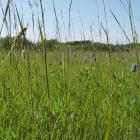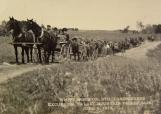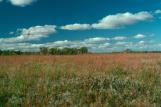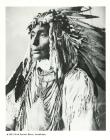1
Prairie, to most people, connotes open windswept landscape, too hot or too cold, containing either plants of little economic importance or vast seas of grain and herds of grazing livestock. To ecologists however, the prairie is a complex and fascinating plant and animal community, a climax ecosystem dominated by grasses.3
Until about a century ago, tall grass, or true prairie, extended from Manitoba south to Texas, from Ohio west to Kansas, and covered more than 250 million acres. Further west, where rainfall is scantier, the tall grass prairie graded into fescue, mixed-grass and then palouse prairie.5
The original tall grass prairie was complex and diverse. The dominant species were big bluestem grass, indian grass, little bluestem grass and switch grass. They varied in height from three to eight feet and formed a dense and at times impenetrable barrier.6
The tall grass prairie in the height of summer.8 March 2004
Living Prairie Museum, St. James, Winnipeg, Manitoba, Canada

7
Other species included forbs such as coneflowers, sunflowers, roses, buttercups and goldenrods. All the flora lent colour and beauty from spring to fall—a wide variety of over 250 grass and forb species in all.The tall grass fauna included bison, pronghorn antelope, grizzly bear, gray wolf, mountain lion, elk, deer, bobcat, coyote and badger. The prairie was also home to the prairie chicken and waterfowls, birds of prey like the burrowing owl, hawk, falcon, and a multitude of grassland songbirds. Thousands of insect species coexisted on the prairie. Many of these fauna were highly restricted in their distribution and are no longer found in the tall grass prairie ecosystem.
9
The first humans in the prairie regions 10,000 years ago or more followed the great roaming herds of bison and other prairie grazers. They hunted for meat, trapped for pelts and harvested the prairie plants for food and medicine.11
In the early 19th century the prairie ecosystem was significantly disrupted with the coming of the Europeans. The first French explorers to see the North American plains called it "a sea of grass". The "prairie", as the French so aptly named it, means ‘wet meadow'.12
Settlers coming in a long line across the prairies.4 June 1912
Last Mountain Valley, Saskatchewan, Canada
 Credits:
Credits:Archives of Manitoba, Settlement 227-230, 1912-1914
13
Consequent explorations revealed a land devoid of trees and rain and it was believed that the land supported only grasses unsuitable for crops. But the political will was to settle the west and before long the sea of grass was cultivated. Under the double onslaught of the plough and grazing livestock, the native flora and fauna began to disappear. Bison herds were wiped out and ploughed fields served as barriers to fires that in earlier times would have swept uncontrolled over the prairie. A new landscape, people and nation emerged out of these plains.14
Manitoba land grants document1882
Manitoba, Canada
 Credits:
Credits:Image courtesy of: Archives of Manitoba



